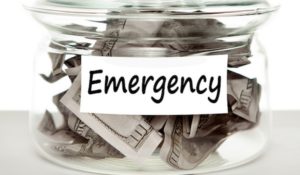How’s your emergency fund?
Are you prepared for unexpected expenses?
A recent survey revealed that >50% of Americans are NOT be able to cover a $400 emergency. There was a time when I too wasn’t able to cover an unexpected emergency and believe me emergencies did happen on more than one occasion. It was a very uncomfortable position to be in. The problem was I didn’t have a plan for my money. There is always a lesson in things that we go through. For me there were a couple of lessons, an emergency fund IS required and emergencies come in different sizes. If you don’t get anything else from this post know that you should ALWAYS have a plan for your money and that includes having a plan for your emergency fund. Let’s be clear on what an emergency is, it includes unexpected events such as a major appliance or vehicle repair, a loss of income due to job loss or severe illness. Not that we are clear on what a true emergency is, let’s talk about the emergency fund.
Establishing an emergency fund doesn’t happen over night and it takes planning and discipline. When I first started, I set my goal at $1,000. I set aside a consistent amount each paycheck and put it in an account not easily accessible. (Still easy enough to get to if an emergency occurred though.) My goal was to increase the amount until I set aside at least 6 months of my salary. (Some recommend setting aside expenses instead of salary, I say salary because it gives you a little extra cushion over your expenses.) Don’t worry if you are not able to contribute much now, the important part is to get started and be consistent adding more as you are able to.
There are lots of things you can do to add to your emergency fund such as sell unused items, pick up a part time job or sell your services.
Having an emergency fund is NOT enough, since unexpected events come in different sizes. In addition to having an emergency fund you need to also have an emergency plan. An emergency plan helps identify when to use your emergency fund and what other actions will be required. It should include what type of emergency activates your emergency fund and to what level. I look at this way, there are 3 categories of emergencies and therefore 3 phases of activation.
- Category 1– Unexpected expense of $1k or less
- Category 2– Unexpected expense between $1k-$5k or an event is temporary as in 90 days or less
- Category 3– Unexpected expense/event over $5k and that is long term and causes a significant shift in income
Depending on your lifestyle and financial situation your category amounts may be different.
Category 1 emergencies require temporary expense cuts until the money used is replenished. Category 2 emergencies require a broader expense cut and temporary lifestyle shift until the money used is replenished. You may want to earn extra income to add back to your emergency fund sooner. Category 3 emergencies require an immediate elimination of all unnecessary expenses, immediate shift to a minimalist lifestyle and immediate activation of your earning extra money plan. Your plan should include details about what expenses would be cut at each stage, what a minimalist lifestyle would be and a plan on how you will earn extra money.
Having a plan prior to an unexpected event helps eliminate the stress that is normally associated with emergencies. It turns what could be a major setback into an inconvenience.
What is your strategy for the unexpected? Let me know in the comments below.
